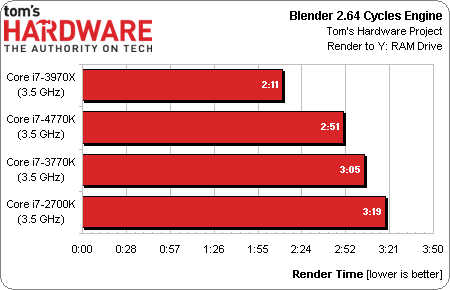Core i7-4770K: Haswell's Performance, Previewed
A recent trip got us access to an early sample of Intel’s upcoming Core i7-4770K. We compare its performance to Ivy Bridge- and Sandy Bridge-based processors, so you have some idea what to expect when Intel officially introduces its Haswell architecture.
Results: Performance Teaser, Per-Clock Perf And Threaded Apps
Per-Clock Performance
First, let's take a look at how Haswell fares against Ivy and Sandy Bridge at a constant 3.5 GHz, with power-saving features and Turbo Boost disabled.

At least in our single-threaded LAME conversion test, Haswell is just over 3% faster than Ivy Bridge and over 5% faster than Sandy Bridge.
Threaded Performance
How about when we turn on all of the chip’s features, and let the Core i7-4770K stand up against Ivy Bridge, Sandy Bridge, and Sandy Bridge-E?

In Blender 2.64, the quad-core Haswell-based part is more than 7% quicker than Core i7-3770K and 14% faster than Core i7-2700K. At the same time, a stock Core i7-3970X is still more than 23% faster than Core i7-4770K. If you were hoping that Haswell would offer an inexpensive quad-core substitute for what will be the two-generation-old Sandy Bridge-E architecture, it’d appear that the six-core design will continue to make sense for anyone with a true workstation.

Our Visual Studio-based Chrome compile benchmark would seem to concur. Think the -3770K and -2700K seem too close together? That’s what I thought at first, until I looked back to this image from our Core i7-3770K launch and saw the same thing. In comparison, Haswell has a huge impact in performance, pretty much cutting the gap between Sandy Bridge and Sandy Bridge-E in half. The six-core chip still reigns supreme in workstation-oriented tasks, but the Core i7-4770K’s >13% advantage over -3770K is stellar.
Get Tom's Hardware's best news and in-depth reviews, straight to your inbox.
Current page: Results: Performance Teaser, Per-Clock Perf And Threaded Apps
Prev Page Results: OpenCL Performance Next Page Results: More Common Desktop Apps-
twelve25 Obviously with AMD striggling, Intel has no need to really stretch here. This is another simple incremental upgrade. Good jump from socket 1156, but I doubt many 1155 owners will feel the need to buy a new motherboard for this.Reply -
EzioAs Thanks for the preview!Reply
So all of these results are what most people expected already: minimal increase in CPU performance while the iGPU shows significant increase? I'm not surprised really (and I believe most people have speculated this), since Haswell mostly targets the mobile segment.
@twelve25
In my opinion though, unless LGA1156 i5/i7 users really want to upgrade (native USB 3.0, more SATA 3, etc), they can still hold out with their current CPUs. Although upgrading to Haswell rather than IB does make much more sense if they really want to but there's also the reported USB 3.0 bug and we haven't seen the thermals and overclocking capability on this chip so it might actually be a turn off for some people. And yeah, I don't think many SB or IB users will upgrade to Haswell. -
dagamer34 @twelve25 But who does Intel really need to convince here? Trying to chase after people who upgrade every year is a fools errand because its such a small piece of the pie compared to the overall larger market. Besides, most of Intel's resources are clearly going towards making mobile chips better, where there energy really needs to be anyway.Reply -
dagamer34 To add to EzioAs's point, I don't see most people on SB/IVB systems upgrading until Intel makes chips that have a good 10-15% better performance than 4.2-4.5Ghz SB/IVB systems or they decide to go down the APU route like AMD is (and also find/create workloads which an APU would beat those systems). In other words, not for another 2+ years.Reply -
Adroid killerchickensDoes Haswell run hot as Ivy Bridge?That = the million dollar question. Did they do away with the bird poop and return to fluxless solder.Reply
Intel should stop throwing insults to the overclocking crowd. We will pay another 10$ for the fluxless solder. -
mayankleoboy1 @ Chris Angelini : Man, you are amazing for this preview! +1 to Toms.Reply
There is no surprise at Intel excluding TSX from the unlocked K parts. They removed teh VT-d in the Sb/IB too. Just so that people not use teh $300 chip in servers, but have to buy th e$2000 chip.
Intel are fucked up
i dont think Intel will be too happy with Toms for this preview.... -
sixdegree Good preview. I kinda hoped that Toms includes the power consumption figure for Haswell. It's the biggest selling point of Haswell, after all.Reply -
mayankleoboy1 sixdegreeGood preview. I kinda hoped that Toms includes the power consumption figure for Haswell. It's the biggest selling point of Haswell, after all.Reply
Power consumptions is a lot dependent on the BIOS optimizations, which are far from final.
